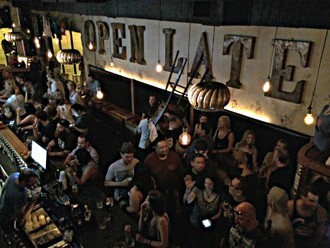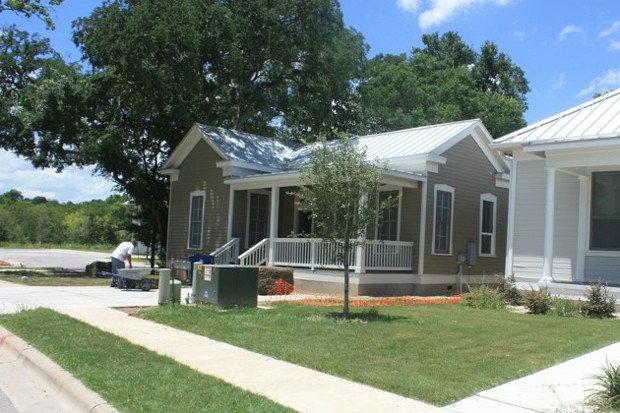Affordable Housing, Always
Gentrification is pushing long-term residents out of urban neighborhoods. Can collective land ownership keep prices down permanently?

AUSTIN, Tex.—Not long ago, inner cities were riddled with crime and blight and affluent white residents high-tailed it to the suburbs, seeking better schools, safer streets, and, in some cases, fewer minority neighbors.
But today, as affluent white residents return to center cities, people who have lived there for years are finding they can’t afford to stay.

Take the case of the capital city of Texas, where parts of East Austin, right next to downtown, are in the process of becoming whiter, and hip restaurants, coffee shops, and even a bar catering to bicyclists are opening. Much of Austin’s minority population, meanwhile, is priced out, and so they’re moving to far-out suburbs such as Pflugerville and Round Rock, where rents are affordable and commutes are long.
“It’s a very bitter pill to swallow for families to be priced out as it becomes a desirable neighborhood,” Mark Rogers, the executive director of the Guadalupe Neighborhood Development Corporation (GNDC), told me.
Rogers and other groups have a bold plan to try and reverse this course: Make homes in the area to affordable—forever.
How, exactly? Rogers is developing community land trusts, through which a local nonprofit acquires a parcel of land and pledges to use it for purposes that benefit the neighborhood, whether that be food production or affordable housing. In the housing model, the nonprofit builds a home on the land and sells it to someone in need. But the nonprofit retains ownership of the land that the house sits on, leasing it to the homeowner for a designated time period, typically 99 years. Dividing the structure from the land has two important benefits: It ensures that the land won’t be sold to developers by keeping it in the community’s possession, but still allows people to buy a home and earn equity on the structure.
As part of the deal, the home will always be affordable. The lease between the homeowner and the nonprofit sets a fixed rate for the house’s appreciation, so that the homeowner builds equity while still keeping the price down for the next buyer.
The first community-land-trust home in the state of Texas is a one-story, mint green house with a wraparound porch in a quiet East Austin neighborhood where prices have skyrocketed in recent years. (A home across the street is currently listed for $859,000; it sold for $349,000 in 2010.)
Mary Ybarra bought the home for $150,000 in 2012, and pays $815 a month on her interest-free mortgage. (GNDC loaned her the money, since it was difficult to get a loan for a land-trust home.) At the time, nearby homes were going for $350,000, which would have been out of reach for Ybarra, a single mother who works as an administrator in an office.
“I would not have been able to get in that league—ever,” she told me, sitting on the porch. “But once the land trust came in, I knew I was on my way somewhere.”
GNDC bought the land where the house sits for less than $20,000 in 1989. When it sold the house to Ybarra in 2012, the land was valued at $120,000 and the house valued at $150,000. But rather than take the profit of the rising land prices, the nonprofit holds onto the land, keeping it affordable for future residents.
The idea of community land trusts isn’t a new one. The idea was first popularized in America as part of the Civil Rights movement, when acommunity activist named Robert Swann decided to try and obtain a large piece of land for black sharecroppers to settle and develop. The backers of that land trust took inspiration from the Jewish National Fund, which at the time was buying up land and setting up settlements in Israel, and the Bhoodan Movement in India, which tried to persuade wealthy landowners to give some of their land to the poor.
Despite Swann’s success, the idea didn’t really take off in urban areas in America until the 1980s, when rapidly increasing real-estate prices began shutting many out of homeownership, according to Reinventing Real Estate: The Community Land Trust as A Social Invention in Affordable Housing, by James Meehan. Cities in states such as Massachusetts, California, and New York embraced the idea. The city of Boston even used eminent domain to clear a portion of land for a local land trust. There are currently 243 community land trusts in the country, the largest of which is in Burlington, Vermont, and leases land to about 500 owner-occupied homes.
But, elsewhere, the idea was slow to catch on. There are few areas more speculative than real estate, and the idea of setting a fixed value for a home’s appreciation made some advocates uneasy. Banks, unaccustomed to loans just for structures and not the properties they sit on, refused to give loans for land-trust homes. Tax assessors charged taxes for the properties based on similar properties in the area, not on the value of the homes as designated in the leases.
That’s all a partial explanation for why the first home to be built on a community land trust in Texas wasn’t completed until 2012. In 2011, a state law made land-trust properties tax-free, and thus more affordable, Rogers said. It was also around that time that Guadalupe was able to find a bank that was willing to give a home loan on a land-trust property. (No community-land-trust loans had been done in Texas before.)

It couldn’t have come at a more crucial time for East Austin. Though the area was designated for residents of color in the city’s 1928 Master Plan, by the mid-2000s, white residents began to move in to be close to the city’s bustling downtown. By 2010, homes were double the price they’d been in 2005. Poor, long-term residents—mostly minorities—began to move out. Between 2000 and 2010, the black population living within city limits fell 4 percent, as the black population in the Austin metro area grew 27 percent. The white population living within Austin’s city limits grew 11 percent, increasing 24 percent in the metro area. Austin is the only large, fast-growing city in America to see its population of African American residents decline between 2000 to 2010.
Mary Ybarra grew up in East Austin, and has seen the neighborhood change dramatically in the past few years. She remembers walking to school with her three sisters and buying piñatas for birthday parties down the street. That piñata shop became the center of the city’s gentrification debate earlier this year when it was torn down—with everything still inside—after the new owners told the piñata-shop owners to vacate the premises and they refused.
“I hardly ever see old friends anymore, because they can’t afford to live here,” she said. Then she gestured to a small home across the street. “That home is renting for $1500 a month.”
Rogers wants to build more land-trust homes to guarantee that more people like Ybarra can stay in the neighborhood. If they can own their own homes, even better, he said. Building equity when owning a house is a good way for low-income families to try and join the middle class.
His group currently has three land-trust properties, as well as 25 vacant lots that will soon be land trusts, he said. GNDC bought real estate in East Austin before prices started climbing, which makes it easier to continue to survive as a non-profit and still keep land cheap. Rogers built one of the land trust properties in 2009 for $100,000—the land and house on that property are now appraised for $575,000. (GNDC supports itself through rental properties it owns, it uses a combination of city funding and donations to make some of its deals.)

It’s possible to create a land trust without deep pockets. After Austin passed a bond to raise money for affordable housing, Guadalupe used some of that money to buy land. Some private developers are also looking at creating land trusts as part of new developments, said Melora Hiller, the executive director of the Community Land Trust Network. The city of Austin created land trusts on some of its properties, and is looking to do more. In Baltimore a community group is looking at creating a land trust to turn vacant homes into residences for the homeless.
There may be more of these trusts created as communities look for ways to keep housing affordable, Hiller said.
“Certainly since the recession, there’s been a huge increase and interest,” she said. “We are constantly getting phone calls from resident groups who are interested in seeing if a community land trust would work for them.”
This has happened in city neighborhoods like Mueller in East Austin, as well as in resort towns where residents realize they need to keep housing affordable for local workers to keep the economies going, Hiller said.
But even neighborhoods that aren’t under threat from gentrification are creating land trusts, knowing that in a culture where cities are “in,” no one is safe from being driven out of a neighborhood. That includes areas of distressed cities such as Detroit and Baltimore.
“The residents are seeing the writing on the wall,” she said. “They see that the prices will go up and they want to make sure they can protect affordability.”
This post originally appeared on The Atlantic.
[Editors Note: In my opinion, this offers a far better solution to the needy population than the developer based non profit housing which ships all the profits to Wall Street Investors and Crony Developers. Imagine a development of small cottages for seniors using this concept.]
No comments:
Post a Comment